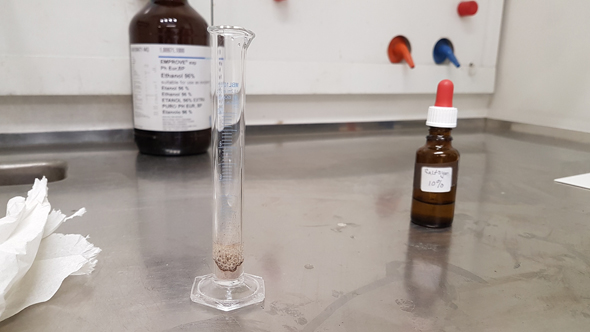If you wanted to cut out a block of peat containing archaeological remains and place it in a wooden box for transport to a museum for excavation indoors, how would you do it? Would you cut out the block, make a wooden box of the correct size and then place the box upside down over the peat block, turn the box over and nail on a wooden lid writing on the lid ”this side up”? Or would you place the box on the ground and lift the block into it the right way up before nailing on the wooden lid on which you would then write ”this way up”. We in the Alvastra Project assumed that the latter course of action was the most likely, largely because of the words ”this way up” printed on the wooden lid of the box. Hans Browall went for the former course of action in his blog post of 27 January 2017. Closer examination shows that Hans was right.
This was shown by a simple test to see how the different layers of the block excavation reacted with hydrochloric acid. The lower layers of Alvastra spring-fed mire contain limestone whereas the upper layers consist of different kinds of peat (Browall 2011, p. 77). If a layer contains limestone it should react strongly to hydrochloric acid. In January 2017 the staff of the Alvastra project subjected soil from two layers to hyrochloric acid. The first layer tested is described as ”above the potsherds”while the second is referred to as ”under the potsherds” (see blog post 11 February 2016). It was in the layer under the potsherds that we recovered the textile fragments that we expected to be Middle Neolithic or older and that turned out to be medieval (see blog post 2016-12-01). Our expectation was based on the idea that the block was the right way up. The samples from these two layers both reacted to the hydrochloric acid but the reaction in the layer above the potsherds was much stronger than that from below the potsherds. This would indicate that the amount of limestone in the layer above the potsherds was greater than that in the layer below the potsherds. This supports the idea put forward by Hans Browall that the stratigraphy of the excavated block was upside down in the box.

Photo: Gregory Strand Tanner, SHM

Photo: Gregory Strand Tanner, SHM
In August 2017 Jens Heimdahl and Jonas Bergman, Quaternary Geologists at the Archaeologists, Swedish History Museum, examined samples from these two layers both macroscopically and microscopically. Their observations also supported Hans Browall’s interpretation of the stratigraphy of the block. The layer above the potsherds consisted of limestone gyttja while the layer under the potsherds consisted of cultural deposits with a large quantity of wood and no remains of sedge roots (sedge is dependent on limestone).
This text terminates our series of seven posts generated by our excavation of the peat block (2016-01-26, 2016,02-11, 2016-02-23, 2016-09-02, 2016-10-26, 2016-12-01, 2017-01-27), unless of course someone has something else to add.
References
Browall, H., 2011. Alvastra pålbyggnad. 1909-1930 års utgrävningar. Kungl. Vitterhets Historie och Antikvitets Akademien handlingar. Antikvariska serien 48. Stockholm.
Bli först att kommentera